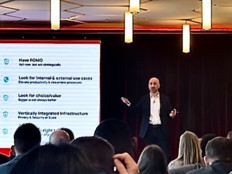How Retailers Can Use the Network to Drive More Successful Customer Loyalty
Retailers typically gain the edge on their competitors when they consistently deliver a superb customer experience. And many retailers’ networks may already be gathering some of the data points that could help them home in on what their customers are truly after, including repeat versus new visitors, connected visitors, time spent in location, peak in-store traffic and more.
Applying analytics to that data can yield even greater insights: market share and forecasting, inventory and distribution, 360-customer views, and mobile application use and penetration. Any retailer planning new infrastructure or an upgrade should consider networking and analytics as well as cloud-based tools when determining how best to leverage the data to transform customer loyalty.
“The Loyalty Report 2018,” now in its eighth year, annually assesses more than 800 loyalty programs in 18 markets, including payments, retail, grocery, gas, dining, entertainment and more. The latest survey highlights several areas where brands may look to improve their loyalty programs, especially through the help of technology tools.
- Go above and beyond points to embrace new loyalty “currencies” and experiences that can be tracked and rewarded. “A growing number of members (87 percent) say they are open to having various details of their activity and behavior watched, monitored and tracked in order to receive access to personalized rewards or engagements,” the report states. Notably, “openness to being tracked is highest among affluent (94 percent), Gen Z (91 percent) and households with children (88 percent).”
- New technology and increasing use of existing technology leads to greater member satisfaction and engagement. “95 percent of members want to engage with brands through a mix of new, emerging and growing tech, including augmented reality, virtual reality, card-on-file and more,” the report continues. “Members who have engaged with loyalty technology say it has substantially improved their member experience.” Automatic, location-based offers, instant points redemption and mobile phone redemption round out the list of touchpoints that most improved customers’ experiences.
- Meeting customer needs in person is essential to improving the experience. “While technology offers a path to increased member engagement, human interactions are more critical than ever and offer brands a cost-effective way to foster loyal relationships with members,” the report states.
DOWNLOAD: Uncover more digital transformation advice from CDW.
Digital Transformation Shouldn’t Wait
When retailers continuously fail to update or keep current on back-end resources to support such programs, they can find themselves falling behind their competitors. Then-necessary rip-and-replace efforts slow future progress and increase the cost of new initiatives. When assessing a digital transformation strategy, retailers should not only consider the technologies they plan to deploy within the next nine to 12 months, but also attempt to anticipate their needs up to five years down the road. While retail IT leaders might not be able to say with certainty which specific applications they’ll be rolling out in half a decade, it’s all but certain that demands on infrastructure will continue to rise, and it’s important for organizations to position themselves to adapt rapidly to a changing environment.
Although new use cases will continue to pop up, the business goals driving the need for IT investments — such as increased customer engagement — will largely remain constant. These are the business drivers that should inform the design and deployment of retail technology solutions. Smart retail is a big-picture approach that identifies not only critical business problems, but also opportunities to improve decision-making and operations through better data.
Investments in the following areas can help stores implement smart retail solutions today while preparing for a changing future:
- Network Solutions: The rise of mobility in recent years has heightened the importance of robust networking solutions, and emerging technologies such as the Internet of Things will only deepen retailers’ reliance on their networks. In addition to wireless technologies such as access points and mobile beacons, many stores beef up investments in areas such as WAN/LAN, telecommunications and software-defined networking. As data analytics use cases become more prevalent, a strong network will ensure retailers are able to accommodate information from customer-facing mobile apps, inventory systems, smart cameras and other IoT endpoints, further driving service and loyalty plays. Strong network service should be available not only to support in-store operational needs, but also in-store wireless for customers, mobile applications, beacons and sensor technology, as well as storage and analytics tools. All of those tools work together to provide a fuller picture of the customer — and retailers’ ability to better serve them — and they rely on a network backbone that must be able to keep all of that data flowing, even through peak use times.
- Data Center/Cloud Solutions: The data center, along with cloud-based solutions, play an enormous role in data analytics initiatives, which require retailers to store and process more information than ever before. As stores grow their capacity, retail executives will need to make decisions about which resources to keep on-premises and which to outsource to the cloud. For retail data analytics in particular, a hybrid cloud approach may make sense, as that allows stores to quickly scale resources up and down according to demand — an essential capability in an industry that sees dramatic seasonal spikes
LEARN MORE: Listen to CDW’s Aaron Lagowski describe a typical Envisioning Workshop, which helps retailers prepare for new technology and IoT.







